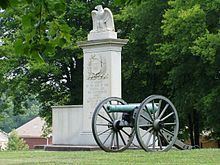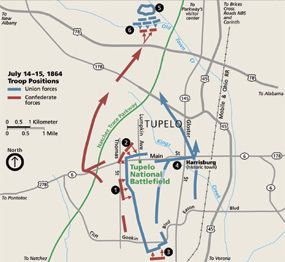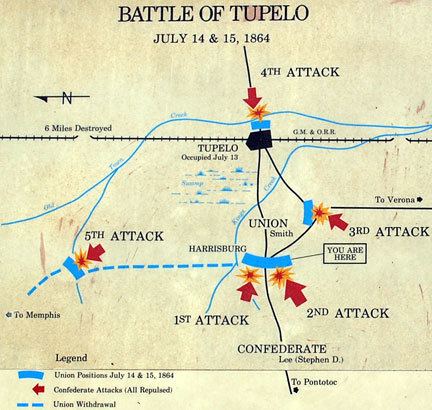Dates 14 Jul 1864 – 15 Jul 1864 | ||
13,000 infantry3,000 cavalry24 guns 2,100 infantry7,000 cavalry20 guns 69 dead and 533 wounded or missing 215 dead and 1,125 wounded or missing Similar American Civil War, Battle of Brice's Crossroads, Meridian Campaign, Siege of Corinth, Battle of Iuka | ||
Battle of tupelo
The Battle of Tupelo (July 14–15, 1864) was fought near Tupelo, Mississippi during the American Civil War. It was a United States victory over Confederate forces in northeast Mississippi ensuring the safety of Major-General William Sherman's supply lines during the Atlanta Campaign.
Contents
Battle of tupelo
Background

The spring and summer of 1864 found the attention of the people of the United States and Confederate States focused on fighting in Virginia and Georgia. Interwoven with, and having important repercussions on, the fighting in northwestern Georgia were military operations in northeast Mississippi designed to prevent Confederate forces under Lieutenant-General Stephen Lee and Major-General Nathan Forrest from striking into middle Tennessee and destroying the single-track railroad over which Sherman's army drew its supplies. The battles of Brice's Crossroads and Tupelo were fought to protect that railroad. it took place where wal-mart stands today.
Prelude

The Right Wing, XVI Army Corps, commanded by Major-General Andrew Smith, advanced into Mississippi from La Grange, Tennessee on July 5 without much opposition in two columns, ravaging the country as it moved, until Pontotoc, Mississippi was closely approached, when Smith's advance was checked by Brigadier-General James Chalmers. Forrest meanwhile made preparations for battle near Okolona, Mississippi. Lieutenant-General Lee was also with the forces, and assumed general command. Three attempts to advance were checked by Forrest's forces, on various roads, and on July 12 both columns turned off toward Tupelo. Lee then moved with the divisions of Chalmers and Brigadier-General Abraham Buford to attack Smith's flank, while Forrest with Mabry's Brigade, the escort, and his old regiment, assailed to the rear. A running fight was kept up for ten miles, but without any considerable advantage to either side except a brilliant dash made upon the Federal wagon train by Chalmers, with Rucker's Brigade, near Bartram's Shop. He had possession of the wagon train for a time and killed all the mules, so the teamsters were compelled to abandon and burn seven wagons, one caisson, and two ambulances.
Union

Confederate

Battle

On the morning of the 14th Smith took a strong position at Harrisburg, Mississippi and entrenched. Lee reacted by forming lines with Roddey's Brigade on the right, Mabry's Brigade on the left, and Crossland's Brigade in the middle. Bell's Brigade, initially supporting Mabry, was put in the front line on Mabry's right. These troops were all dismounted. Both Chalmers' and Buford's divisions were held in reserve. The plan of attack seemed to be swing the right, but Lyon's Brigade became engaged first and was forced to fall back with heavy loss. Chalmers' Division, dismounted, was ordered forward and after Mabry and Bell had been repulsed, Rucker's Brigade made an equally futile assault. The men behaved with great courage, but were swept away by the fire of a superior and entrenched force, and many fell from exhaustion in the great heat of a July sun. A little after noon the Confederates fell back and entrenched, but were not molested by the Federals, who contented themselves with tearing up railroad in the vicinity of Tupelo and burning the houses of Harrisburg.

On the 15th, it appearing Smith would not attack, Buford's Division made a demonstration on his left flank. Soon afterward Smith began his retreat, and a vigorous pursuit was at once begun. At Old Town Creek Buford came up with the Federals in line of battle and was driven back in confusion. McCulloch's Brigade was ordered to attack, but being sent in by regiments was speedily repulsed. Forrest and Colonel Robert McCulloch were both severely wounded, and command of the forces in front devolved upon Chalmers. Though the pursuit was continued, there was but slight skirmishing after this engagement.
Aftermath
Sherman, who was closing in on Atlanta, was irritated Smith had not pressed Forrest at Tupelo, believing he should not have been allowed to escape. If Forrest had been allowed to raid into middle Tennessee prior to the fall of Atlanta, it could have had disastrous consequences for the U.S. Although Smith failed to destroy Forrest's Cavalry Corps at Tupelo, he did break its combat effectiveness. Forrest would rally his horsemen for more daring raids, but never again would they be able to fight and defeat infantry. The conflict is commemorated at the Battle of Tupelo National Historic Site, established in 1929.
